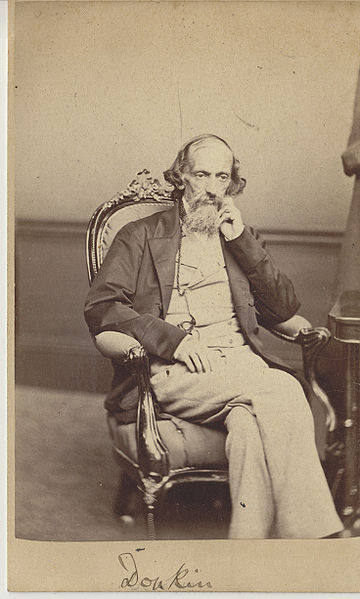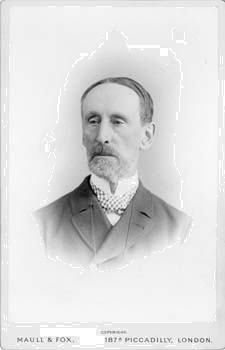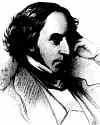<Back to Index>
- Astronomer and Mathematician William Fishburn Donkin, 1814
- Mathematician Morgan Crofton, 1826
- Polymath Robert Leslie Ellis, 1817
PAGE SPONSOR

William Fishburn Donkin (15 February 1814 – 15 November 1869) was an astronomer and mathematician, and Savilian Professor of Astronomy at the University of Oxford.
He was born at Bishop Burton, Yorkshire, the son of Thomas Donkin, Land Agent, and was educated at St Peter's School, York and (from 1832) St Edmund Hall, Oxford He was a nephew of Bryan Donkin.
In 1844 he married Harriet, the third daughter of the Revd John Hawtrey of Guernsey. They had six children: William Frederick (an explorer and mountaineer), Arthur (assistant master, Rugby School), Alice Emily (a painter), Alfred, Edward and Reginald.
He was a contemporary of Charles Dodgson (Lewis Carroll).
Donkin's
constitution was always delicate, and failing health compelled him to
live much abroad during the latter part of his life. He died at his home
in Broad Street, Oxford.
From an early age Donkin showed talent for languages, mathematics, and music. In 1834 he won a classical scholarship at University College, Oxford, where in 1836 he obtained a double first class in classics and mathematics (BA 1836, MA 1839). In 1837 he won the mathematical and Johnson mathematical scholarships.
He was a fellow of University College, and for about six years was a mathematical lecturer at St Edmund Hall. During this period he wrote an early statistical essay for the Ashmolean Society, the ‘Essay on the theory of the combination of observations’. He also contributed some papers on Greek music to Dr Smith's Dictionary of Antiquities.
In 1842 Donkin was elected Savilian Professor of Astronomy, a post which he held for the remainder of his life. That year he was elected a Fellow of the Royal Society and the Royal Astronomical Society.
Between 1850 and 1860 Donkin contributed several important papers to the Philosophical Transactions, including ‘On a class of differential equations, including those which occur in dynamical problems’ (PTRS, 144, 1854) and ‘The equation of Laplace's functions’ (PTRS, 147, 1857). In these and other papers he drew upon W.R. Hamilton's theory of quaternions. He also deployed the symbolic methods of solving differential equations widely used by English mathematicians at the time; a major figure was George Boole, who published some of Donkin's results in his Treatise on Differential Equations (1859). They included new ways of solving Laplace's equation, and also an important equation due to Laplace concerning potentials of a nearly spherical spheroid (such as the earth). He and Boole also exchanged ideas on methods of computation in probability theory. In 1861 he read an important paper to the Royal Astronomical Society entitled ‘The secular acceleration of the moon's mean motion’ (printed in the society's Monthly Notices for 1861). He was also a contributor to the Philosophical Magazine, his last paper in which, ‘Note on certain statements in elementary works concerning the specific heat of gases’, appeared in 1864.
Donkin's acquaintance with practical and theoretical music was very thorough. His work on acoustics,
intended to be his opus magnum, was commenced in 1867, and the fragment
of it which he completed was published, after his death, in 1870.
Basing his mathematical treatment on Fourier series, he covered transverse and lateral vibrations of strings and rods, and free and forced oscillations. He also examined the composition of the musical scale, and had intended to present musical theory and practice in a third part. The second part would have treated elastic membranes,
plates and solids, and the mathematical theory of sound. Although
incomplete, his book was the principal work in English on this topic
until Lord Rayleigh's Theory of Sound appeared in two volumes in 1877 and 1878. Among other interests, Donkin also corresponded on geometrical problems with William Spottiswoode.

Morgan Crofton (1826, Dublin, Ireland – 1915, Brighton, England) was a mathematician who contributed to the field of geometric probability theory. He also worked with James Joseph Sylvester and contributed an article on probability to the 9th edition of the Encyclopædia Britannica. Crofton's formula is named in his honor.
As a person he was the child of Reverend William Crofton, Rector of Skreene, Co Sligo, but converted to the Roman Catholic Church in the 1850s in part due to an interest in Newman. This led to his resignation at Queen's College, Galway, and transference to various Catholic colleges.
He was Professor of Mathematics at the Royal Military Academy, Woolwich, and Professor of Natural Philosophy at Queen's University of Ireland. He was elected a Fellow of the Royal Society in June, 1868.
He
married twice: firstly on 31 August 1857 Julia Agnes Cecilia, daughter
of J B Kernan (died 1902) and secondly Katherine, daughter of Holland
Taylor of Manchester. Later his son became a priest.

Robert Leslie Ellis (25 August 1817 – 12 May 1859) was an English polymath, remembered principally as a mathematician and editor of the works of Francis Bacon.
Ellis was the youngest of six children of Francis Ellis (1772 – 1842) of Bath. Educated privately, he entered Trinity College, Cambridge, in 1836, graduating as Senior Wrangler in 1840 and elected Fellow of Trinity shortly afterwards. Although he had also entered the Inner Temple in 1838, was called to the bar in 1840, and later helped William Whewell with jurisprudence, Ellis never practiced law. He hoped unsuccessfully for the Cambridge chair of civil law.
Inheriting substantial Irish estates when his father died, Ellis contemplated entering Parliament as a Whig under Sir William Napier's patronage. Yet his courtship of one of Napier's daughters ended in some confusion: Ellis never married, and never stood for Parliament.
As a mathematician, Ellis founded the Cambridge Mathematical Journal with D.F. Gregory in 1837. His own major mathematical contributions were on functional and differential equations, and the theory of probability ('On the foundations of the theory of probabilities', 1849). Philosophically, Ellis (like George Boole and later John Venn) defended an objective rather than subjective theory of probability. He corresponded with Augustus De Morgan on the conjectured four color theorem.
Ellis took on the editing of Francis Bacon's works with two other Trinity fellows, Douglas Denon Heath and James Spedding. Dramatic deterioration of Ellis's health from 1847 left his work on the general prefaces to Bacon's philosophy unfinished. Spedding and Heath completed the Works in seven volumes, published 1857 - 1859.
Continental travel failed to restore Ellis' health. An attack of rheumatic fever at Sanremo in 1849 left him an invalid, and he returned to Cambridge, living at Anstey Hall, Trumpington, next to his friend John Grote, vicar of Trumpington. From his sickbed he kept up contact with the young Trinity mathematician William Walton, and dictated his thoughts on a wide range of topics, including etymology, bees' cells, Roman money, the principles of a projected Chinese dictionary, and Boole's The Laws of Thought (1854). He translated Dante, Roman law texts and Danish ballads; a gentle melancholia suffuses the lines of his own poetry which he left in manuscript.
William Walton edited a posthumous collection of both published and unpublished writings, in The mathematical and other writings of R.L. Ellis (1863): this was prefaced by a biographical memoir by Harvey Goodwin. Correspondence and notebooks of Ellis are amongst the Mayor Papers and Whewell Papers at Trinity College, Cambridge.